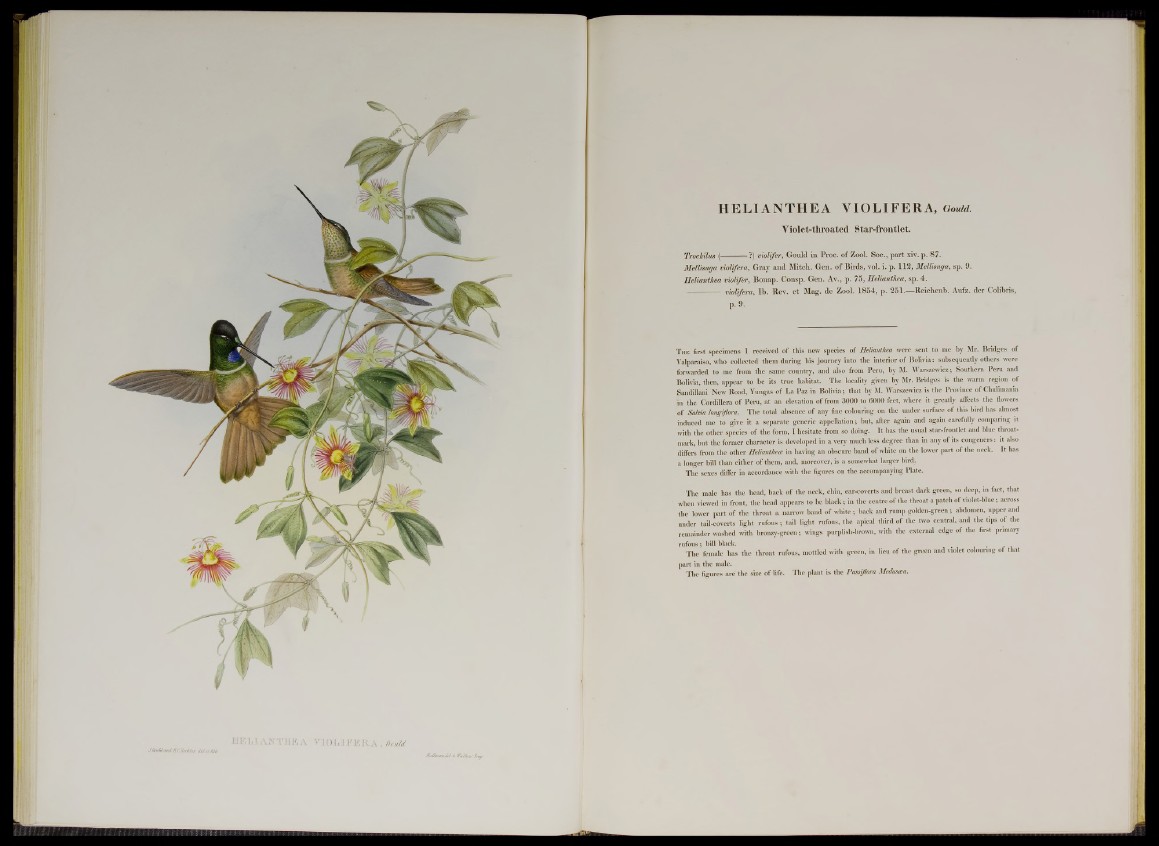
JOmW.tmtVJïClUclda- Mel hi A
U L U i
HE L IAN THE A VIOLIFERA, Gould.
Violet-throated Star-frontlet.
Trochilus (------------?) violifer, Gould in Proc. o f Zool. Soc., p a rt xiv. p. 87.
Mellimga violifera, Gray and Mitch. Gen. of Birds, vol. i. p. 112, Mellimga, sp. 9.
Helianthea violifer, Bonap. Consp. Gen. Av., p . 75, Helianthea, sp. 4.
violifera, lb . Rev. e t Mag. de ZooÎ. 1854, p. 251.-—Reichenb. Aufz. der Colibris,
p. 9.
T he first specimens I received of this new species of Helianthea were sent to me by Mr. Bridges of
Valparaiso, who collected them during his journey into the interior of Bolivia: subsequently others were
forwarded to me from the same country, and also from Peru, by M. Warszewicz; Southern Peru and
Bolivia, then, appear to be its true habitat. The locality given by Mr. Bridges is the warm region of
Sandillani New Road, Yungas of La Paz in Bolivia; that by M. Warszewicz is the Province of Chulimania
in the Cordillera of Peru, at an elevation of from 3000 to 6000 feet, where it greatly affects the flowers
of Salvia longiflora. The total absence of any fine colouring on the under surface of this bird has almost
induced me to give it a separate generic appellation; but, after again and again carefully comparing it
with the other species of the form, I hesitate from so doing. It has the usual star-frontlet and blue tliroat-
mark, but the former character is developed in a very much less degree than in any of its congeners: it also
differs from the other Helianthea in having an obscure band of white on the lower part of the neck. It has
a longer bill than either of them, and, moreover, is a somewhat larger bird.
The sexes differ in accordance with the figures on the accompanying Plate.
The male has the head, back of the neck, chin, ear-coverts and breast dark green, so deep, m fact, that
when viewed in front, the head appears to be black; in the centre of the throat a patch of violet-blue; across
the lower part of the throat a narrow band of white ; back and rump golden-green; abdomen, upper and
under tail-coverts light rufous; tail light rufous, the apical third of the two central, and the tips of the
remainder washed with bronzy-green; wings purplish-brown, with the external edge of the first primary
rufous; bill black. _ #
The female has the throat rufous, mottled with green, in lieu of the green and violet colouring of that
part in the male.
The figures are' the size of life. The plant is the Passi/lora Medusaa.